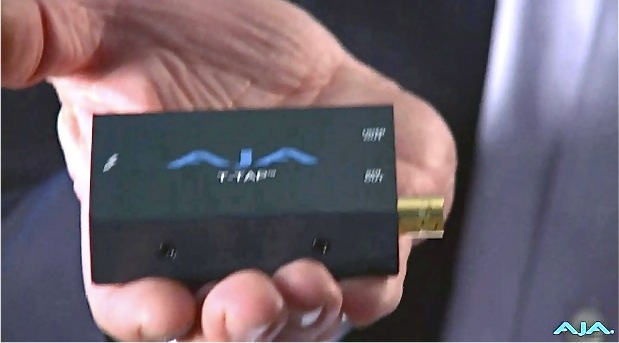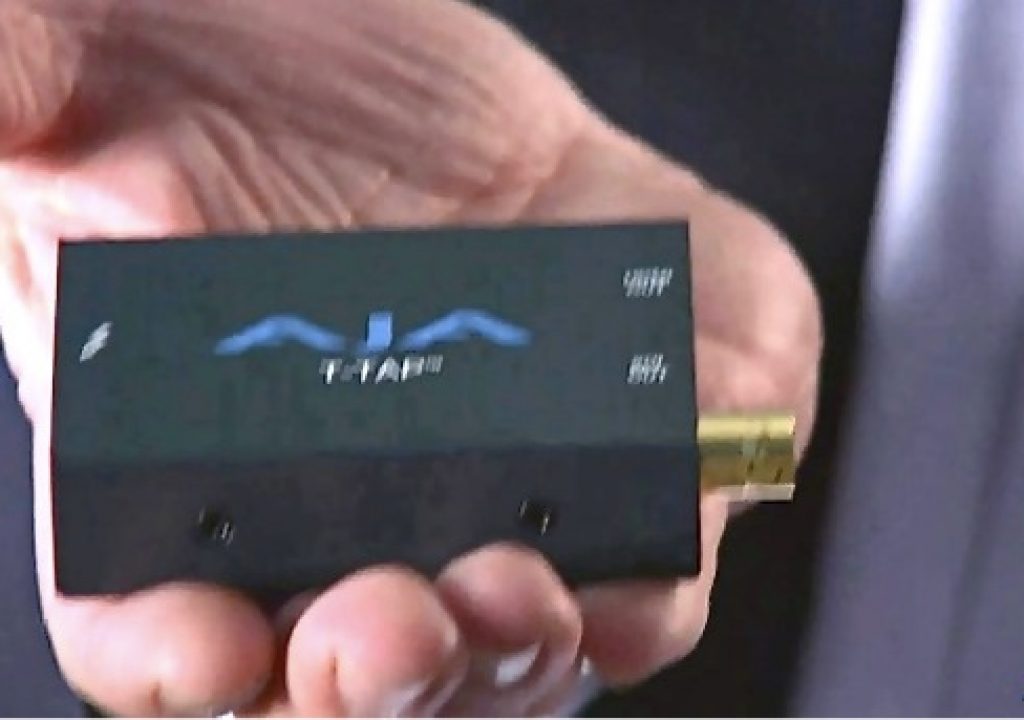
As I have covered in great detail in several prior articles here in ProVideo Coalition magazine, the most complete and most reliable method of connecting your critical video monitor to your computer based editing system is via a professional a/v i/o interface, like those Thunderbolt models now offered by AJA, Blackmagic, Matrox, and now even MOTU. However, most of them are more than what many editors need today in the tapeless acquisition, file-based era. Often editors no longer require any audio or video input at all, since the material primarily arrives in file-based format. That’s why AJA decided to design and build a simpler, lower-priced, self-powered, output-only device called the T-TAP at NAB 2012. The outputs are SDI and HDMI. This article will cover all of the specs (even some vital ones that AJA hasn’t yet published), applications, recommended connections, and define whether the T-TAP is appropriate or not for use with HP’s DreamColor monitor.
T-TAP’s input
The T-TAP’s only input is Thunderbolt, and it is self (bus) powered. Since the T-TAP is a Thunderbolt end-point (termination), the T-TAP should be connected after all of the daisy-chainable (loopable) devices, like your Thunderbolt storage.
T-TAP’s outputs
The T-TAP has an SDI output and an HDMI output. Both outputs are potentially true 10-bit (which is sometimes expressed as 30-bit, since it is 10-bit per color channel). I say potentially true 10-bit, because -like with any such system- the monitor (processing + panel) must be 10-bit to take full advantage, and the source video must have been originally at least 10-bit (not derived from 8-bit).
Is T-TAP appropriate for the HP Dreamcolor monitor?
As I have stated in several prior articles, our beloved HP Dreamcolor monitor’s DreamColor engine is quite picky. It must receive a signal that is both true progressive (not interlaced and not even PsF), and RGB, not component (YUV). As of NAB 2012, the AJA website already listed the compatible framerates for the T-TAP, which fortunately include several that are true progressive. The T-TAP is actually capable of outputting sub-HD (i.e. standard definition 480i/486i derived from NTSC and 576i derived from PAL) and beyond HD (2K). However, below I’m listing only the HD formats with comments.
- 720p: 50, 59.94, 60.000 (perfect for the DreamColor engine, either 1:1 or upscaled)
- 1080i 25, 29.97, 30.000 (previously known as 50i, 59.94i, and 60.000i) (no good for the DreamColor engine since this is interlaced)
- 1080PsF 23.976, 24.000, 25, 29.97 (no good for the DreamColor engine because this is PsF)
- 1080p 23.976, 24.000, 25, 29.97 (perfect for the DreamColor engine at 1:1)
As of NAB 2012 the AJA website states that the T-TAP outputs: “8-bit 4:2:2 and 10-bit 4:2:2” over HDMI, and (as many of you know) 4:2:2 is component (YUV) which is Kryptonite for the DreamColor engine (yikes!). That’s why I asked Bryce Button of AJA during our NAB interview whether the T-TAP can also be set to output RGB (4:4:4) over HDMI, as many other AJA products can. He checked with someone else and within a few minutes fortunately gave me the good news: Even though the T-TAP does not contain hardware to carry out color transcoding (i.e. YUV>RGB or RGB>YUV), the T-TAP software control panel will indeed allow selecting the option to force RGB output from the T-TAP’s HDMI output to satisfy the DreamColor engine requirement. So if the original timeline video is YUV, the AJA software will convert it to RGB/4:4:4 so the T-TAP’s HDMI output can feed the DreamColor monitor. Presumably, if the footage is already RGB/4:4:4 (i.e. ProRes4444 footage on a 4:4:4 timeline) it will simply leave it alone in that case. I imagine that AJA will update its website to indicate this sometime soon. I will update this article and/or write another article if and when I receive more information about this from AJA, and I am on the list to receive a review unit of the T-TAP, so I can actually verify its compatibility with a DreamColor monitor when I write my review about it.
To make sure you continue to see my upcoming articles, sign up to my mailing list here.
Related Thunderbolt articles
- Thunderbolt in MacBook Pro: a new era for demanding video editors who prefer laptops from February 27th, 2011
- Mac Mini w/Thunderbolt: preferred platform for many new editing systems from August 8th, 2011
- Blackmagic delivers its first Thunderbolt-based i/o interface, the UltraStudio 3D from September 5th, 2011
- Matrox adds optional Thunderbolt connectivity to existing MXO2 family interfaces from September 5th, 2011
- AJA announces Io XT interface with Thunderbolt at IBC in Amsterdam from September 9, 2011
- Blackmagic breaks Thunderbolt price budget with US$299 Intensity Extreme from September 9, 2011
- Mac Mini for pro video editing: a field report from Guatemala:
Despite gloomy predictions from the naysayers, the Mac Mini beats the MacPro tower for video editing from October 18, 2011 - Pegasus Thunderbolt RAID5 from PROMISE: The high-performance video RAID5 you need for today’s modern Mac systems from January 31, 2012
- AJA’s Io XT w/ Thunderbolt is now available, but it is not Riker: What’s the cover-up? Why are William Riker and Leo Laporte involved in a Pegasus cover-up? from January 31, 2012
Related DreamColor articles
- Allan T©pper’s: Does Premiere CS5 achieve the “impossible dream” for critical evaluation monitoring?
- Allan T©pper’s: Why should I care if my monitor shows ITU Rec.709?
- Allan T©pper’s: Who is the ITU, and why should I care?
- Allan T©pper’s: How to connect your HD evaluation monitor to your editing system properly: Let me count the ways!
- Allan T©pper’s review: DreamColor from HP: an ideal tool for critical image evaluation
- Patrick Inhofer’s review: HP’s DreamColor: A PVM CRT Replacement?
- Allan T©pper’s: DreamColor direct interfaces
- Allan T©pper’s: DreamColor converter boxes for non-compliant systems
- Allan T©pper’s: Matrox’s original MXO crashes the Direct DreamColor interface party from January 10, 2010
- Art Adam’s: GEEK OUT: The Non-Technical Technical Guide to Sony OLED Monitors from March 6, 2012
- Allan T©pper’s Bandito Brothers use multiple HP DreamColors + Adobe Premiere for Act of Valor from March 9, 2012
Allan T©pper’s books, consulting, articles, seminars & audio programs
Contact Allan T©pper for consulting, or find a full listing of his books, articles and upcoming seminars and webinars at AllanTepper.com. Listen to his TecnoTur program, which is now available both in Castilian (aka “Spanish”) and in English, free of charge. Search for TecnoTur in iTunes or visit TecnoTur.us for more information.Disclosure, to comply with the FTC’s rules
No manufacturer is specifically paying Allan T©pper or TecnoTur LLC to write this article. Some of the other manufacturers listed above have contracted T©pper and/or TecnoTur LLC to carry out consulting and/or translations/localizations/transceations. Many of the manufacturers listed above have sent Allan T©pper review units. So far, none of the manufacturers listed above is/are sponsors of the TecnoTur programs, although they are welcome to do so, and some are, may be (or may have been) sponsors of ProVideo Coalition magazine. Some links to third parties listed in this article and/or on this web page may indirectly benefit TecnoTur LLC via affiliate programs.
Copyright and use of this article
The articles contained in the TecnoTur channel in ProVideo Coalition magazine are copyright Allan T©pper/TecnoTur LLC, except where otherwise attributed. Unauthorized use is prohibited without prior approval, except for short quotes which link back to this page, which are encouraged!

